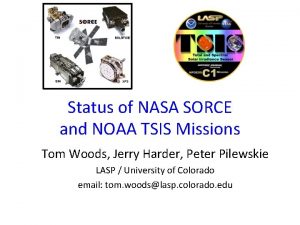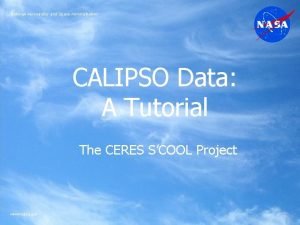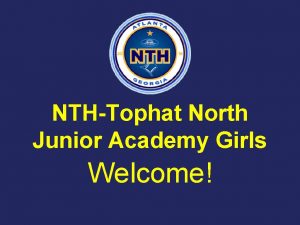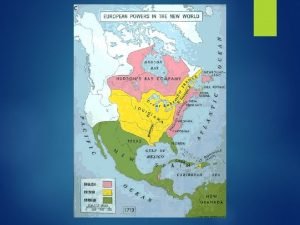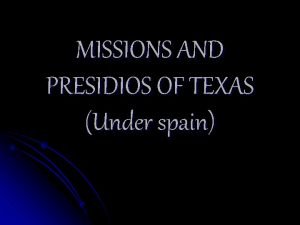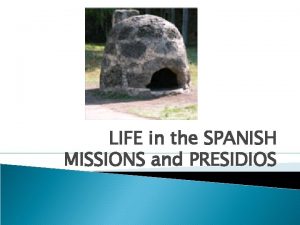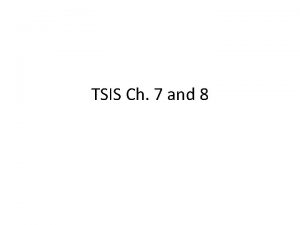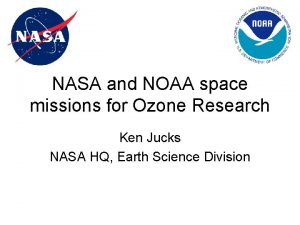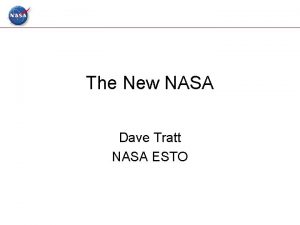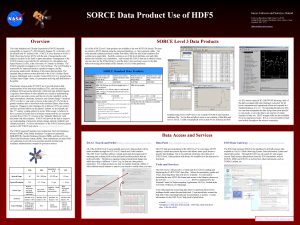Status of NASA SORCE and NOAA TSIS Missions






- Slides: 6

Status of NASA SORCE and NOAA TSIS Missions Tom Woods, Jerry Harder, Peter Pilewskie LASP / University of Colorado email: tom. woods@lasp. colorado. edu

Significant Progress on Solving TSI Offsets Over the last 2 years the SORCE/TIM value for the total solar irradiance (TSI) has gained much acceptance through laboratory validations with other TSI instruments at LASP’s TSI Radiometer Facility (TRF) – TRF test results indicate that the other TSI instruments report high values due to internal instrument scatter See Kopp & Lean (GRL, 2011) paper for some of the TRF comparison results VIRGO-ground Scatter New ACRIM Product – TRF Comparison Results Instrument SORCE / TIM ground Glory / TIM flight PREMOS -1 ground PREMOS-3 flight VIRGO-2 ground ACRIM-3 ground Scatter Contribution (W/m 2) 0 0 1. 3 0. 5 2. 1 9. 4

Different SSI Variability Observed with SORCE 2004(Active Sun) compared to 2007(Quiet Sun) Wavelength • SORCE SSI composite irradiance (Harder et al. , GRL, 2009) • • • Constructed from SORCE SOLSTICE and SIM irradiance measurements Shows 3 -5 x more variability in UV than SSI model and very different distribution in the visible (some wavelengths out of phase with cycle) Both NRL and SORCE SSI give the same integrated irradiance (TSI) • NRL SSI model • • • A standard representation for solar variability Based on 2 -component model of sunspot dimming and facular brightening Used extensively in climate model studies (i. e. CCMVal)

SORCE SSI Observations Better Explain Mesospheric Ozone Trends NRLSSI O 3 Difference (%) Active 2004 -Quiet 2007 SABER O 3 Difference (%) (2002/3) - (2008/9) SORCE O 3 Difference (%) Active 2004 -Quiet 2007 O 3 Difference (%) Avg. 15ºN-15ºS Latitude Results from Merkel et al. (GRL, 2011) • • • Modelling study using NCAR’s WACCM (Whole Atmosphere Community Climate Model). Shows response of atmospheric ozone when forced by both NRL and SORCE SSI. Compares the Model results with SABER observations. Panel on right shows equatorial response of all three (2 model runs and SABER obs. ) The comparisons imply that the higher SORCE UV variability improves the model/data agreement of daytime mesospheric ozone. Suggests enhanced HOx photochemistry with greater SORCE solar UV variability

SORCE mission is limited by battery life • SORCE mission has far exceeded its prime mission of 5 years (launched in Jan. 2003), and some spacecraft components are starting to have limited-life issues. – One of the reaction wheels has been turned off due to high friction, but other three reaction wheels are healthy. Solar pointing remains well within original requirements. – Some of the battery cells have significant degradation. SORCE operations might end in 2016 based on the battery life predictions. • Power management for the battery has forced us to operate XPS, SOLSTICE, and SIM instruments only on orbit day-side. The TIM instrument remains on during orbit eclipse to provide more stable TSI measurement. • Power cycling the instruments causes wider temperature swings over the orbit and thus larger corrections in data processing for the SSI instruments. • Regular weekly calibrations have been forced to be only 5 times per year, but this lower cadence does not appear to affect data quality. • NASA intends to fund SORCE mission for 5 more years

Will there be a SORCE – TSIS gap? • NOAA TSIS (TIM & SIM instruments) are currently in development at LASP and could be ready for a flight in 2013. However, NOAA/NASA plans to launch TSIS soon (e. g. in 2015) is highly uncertain due to USA budget planning for 2012 and beyond. – NASA Glory launch failure in 2011 poses new risk for TSI data gap. SOHO, ACRIMSat, and PICARD also provide TSI observations, but SOHO and ACRIMSat are even older than SORCE and PICARD prime mission is only 2 years. – ISS SOLSPEC could also provide SSI observations, although none are publicly available now, and ISS SOLSPEC is in extended mission period already. How long can old missions last? How soon can TSIS be launched?
